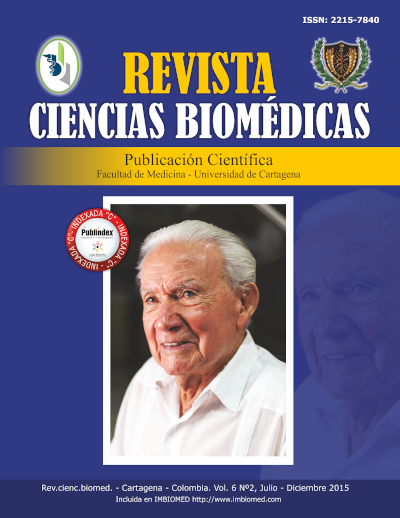Ependimoma mixopapilar osteolítico gigante del sacro: una forma agresiva de un tumor benigno
Ependimoma mixopapilar osteolítico gigante del sacro: una forma agresiva de un tumor benigno
Contenido principal del artículo
Resumen
Introducción: el ependimoma mixopapilar (EM) es un tumor glial ependimario que afecta predominantemente a los adultos jóvenes, se origina en el filum terminale, la cauda equina y el cono medular.
Caso clínico: se presenta el caso de una paciente en quien durante el estudio de un dolor radicular se logra detectar ependimoma mixopapilar gigante, el cual comprometía gran parte del hueso sacro, mostrando un comportamiento localmente agresivo con intensa osteólisis.
Conclusión: se discutieron las posibles teorías que explican la presencia de estos tumores a nivel sacro, en especial la presencia de remanentes embrionarios de tejido ependimario en los niveles más caudales del canal vertebral y los posibles mecanismos que explican el comportamiento agresivo de estos tumores histológicamente benignos. Rev.cienc.biomed. 2015; 6(2):348-353
Palabras clave:
Descargas
Detalles del artículo
Referencias (VER)
Pica A, Miller R, Villa S, Kadish SP, Anacak Y, Abusaris H, et al. The results of surgery, with or without radiotherapy, for primary spinal myxopapillary ependymoma: a retrospective study from the rare cancer network. Int J Radiat Oncol Biol Phys. 2009;74:1114-20.
Quraishi NA, Wolinsky JP, Bydon A, Witham T, Gokaslan ZL. Giant destructive myxopapillary ependymomas of the sacrum. J Neurosurg Spine. 2010;12:154-9.
Gupta R, Rishi A, Suri V, Sharma MC, Gupta A, Garg A, et al. Sacral myxopapillary ependymoma with extensive osteolysis. J Neurooncol. 2008;86:349-52.
Chung JY, Lee SK, Yang KH, Song MK. Subcutaneous sacrococcygeal myxopapillary ependymoma. AJNR Am J Neuroradiol. 1999;20:344-6.
Biagini R, Demitri S, Orsini U, Bibiloni J, Briccoli A, Bertoni F. Osteolytic extra-axial sacral myxopapillary ependymoma. Skeletal Radiol. 1999;28:584-9.
Fassett DR, Schmidt MH. Lumbosacral ependymomas: a review of the management of intradural and extradural tumors. Neurosurg Focus. 2003;15:E13.
Chakraborti S, Govindan A, Alapatt JP, Radhakrishnan M, Santosh V. Primary myxopapillary ependymoma of the fourth ventricle with cartilaginous metaplasia: a case report and review
of the literature. Brain Tumor Pathol. 2011.
Lim SC, Jang SJ. Myxopapillary ependymoma of the fourth ventricle. Clin Neurol Neurosurg. 2006;108:211-4.
DiLuna ML, Levy GH, Sood S, Duncan CC. Primary myxopapillary ependymoma of the medulla: case report. Neurosurgery. 2010;66:E1208-9; discussion E9.
Tseng YC, Hsu HL, Jung SM, Chen CJ. Primary intracranial myxopapillary ependymomas: report of two cases and review of the literature. Acta Radiol. 2004;45:344-7.
Estrozi B, Queiroga E, Bacchi CE, Faria Soares de Almeida V, Lucas de Carvalho J, Lageman GM, et al. Myxopapillary ependymoma of the posterior mediastinum. Ann Diagn Pathol.
;10:283-7.
Schittenhelm J, Becker R, Capper D, Meyermann R, Iglesias-Rozas JR, Kaminsky J, et al. The clinico-surgico-pathological spectrum of myxopapillary ependymomas--report of four unusal cases and review of the literature. Clin Neuropathol. 2008;27:21-8.
Shors SM, Jones TA, Jhaveri MD, Huckman MS. Best cases from the AFIP: myxopapillary ependymoma of the sacrum. Radiographics. 2006;26:111-6.
Sonneland PR, Scheithauer BW, Onofrio BM. Myxopapillary ependymoma. A clinicopathologic and immunocytochemical study of 77 cases. Cancer. 1985;56:883-93.
Cho HY, Lee M, Takei H, Dancer J, Ro JY, Zhai QJ. Immunohistochemical comparison of chordoma with chondrosarcoma, myxopapillary ependymoma, and chordoid meningioma. Appl Immunohistochem Mol Morphol. 2009;17:131-8.
Hussein SA, Sur M. Cytokeratin positivity in myxopapillary ependymoma--a potential diagnostic pitfall. Diagn Pathol. 2008;3:40.



 PDF
PDF
 FLIP
FLIP




